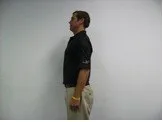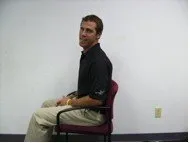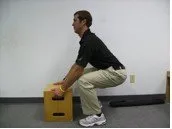Reduce or Eliminate Back and Neck Pain
Good Posture, Exercise and Overall Fitness Can Help
By Lettie Anderson, MSPT
Many People Suffer from Back Pain and Neck Pain
Do you find yourself slumped over your steering wheel at red lights? Do you hover over your computer on a daily basis? If so, then you may suffer from back and neck pain just like many other Americans.
Eight out of ten people suffer from back pain at some point in their lives. Of course there are many causes for this, but most back pain is brought on by poor posture and poor body mechanics. The back pain can be intermittent and last for only a few hours, but can become chronic in nature and last for months.
Avoiding Poor Posture
Poor posture can cause abnormal stress and strain on the muscles and ligaments in your spine. Over time these structures can begin to suffer mechanical breakdown which causes you to feel pain. If not corrected, this pain can become so severe that it can be quite debilitating.
Making Good Posture a Habit
What is good posture? Proper posture involves sitting, standing, or walking in an upright position that places the least amount of strain on supporting muscles and ligaments during movement or weight-bearing positions.
CORRECT STANDING POSTURE
- Hold your head up straight with your chin tucked in
- Line your earlobes up with the middle of your shoulders
- Keep your shoulder blades back with your chest forward
- Keep your knees straight
- Keep your stomach muscles pulled in

CORRECT SITTING POSTURE
- Hold your head up straight with your chin tucked in
- Sit with your back straight and shoulder blades back
- Your buttocks should touch the back of the chair
- To maintain a normal curve in your low back, place a small, rolled-up towel or lumbar roll in the small of your back

Good Body Mechanics Plays A Role Too
Proper body mechanics are also very important to prevent back pain. This entails maintaining proper posture during movement. Repetitive movements done in an incorrect way can cause stresses to your muscles and ligaments that can lead to injury over time.
CORRECT LIFTING POSITION
- Before lifting an object, make sure that its weight is manageable for you
- Stand with a wide stance as close as possible to the object
- Bend down at your knees and hips maintaining your back in a straight position
- Tighten your stomach muscles and stand up using your leg muscles

Exercise and Stretch Your Way to a Healthy Back
In order to maintain good posture and body mechanics one must have appropriate flexibility and strength in postural muscles and lumbar stabilizer muscles. The following exercises are helpful in maintaining these:
- Chin tucks or cervical retraction: pull your chin straight back while sitting/standing up straight. Hold for 10 seconds, repeat 10-20 times.
- Scapular squeezes: pull your elbows behind you while squeezing your shoulder blades together. Hold for 5 seconds, repeat 10-20 times.
- Pectoral stretch: Stand in a doorway with each hand behind doorjamb, step through the doorway with one leg. The stretch is felt across the chest. Hold for 30 seconds and repeat 3 times.
- Hamstring stretch: Lie on your back with your knees bent. Bring one knee toward your chest, holding behind the knee, and attempt to straighten the leg as far as possible. The stretch is felt in the back of the thigh and calf. Hold for 30 seconds and repeat 3 times.
- Abdominal Crunches: Lie on your back with your knees bent. Squeeze in your abdominal muscles and gently lift your upper body up only until you clear your shoulder blades from the floor. Lower your upper body slowly back to the floor. Repeat 10-30 times.
Overall Fitness, Posture and Body Mechanics Work Together to Eliminate or Reduce Back or Neck Pain
Maintaining your overall body fitness can help prevent injury. Proper posture and correct body mechanics are important tools to living a healthy life without neck or back pain.
